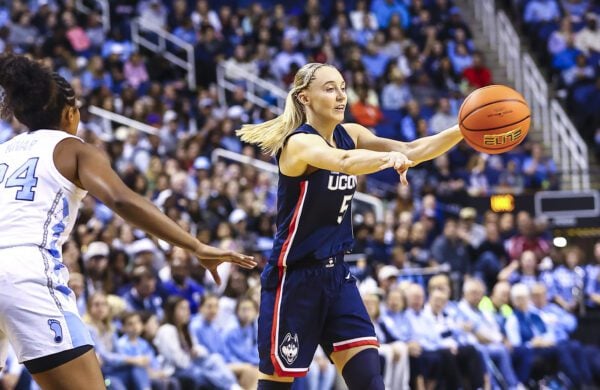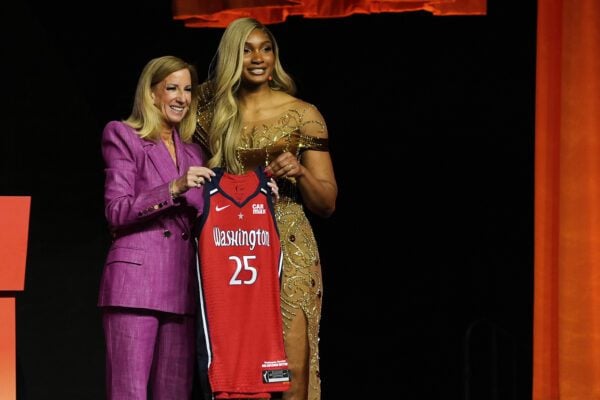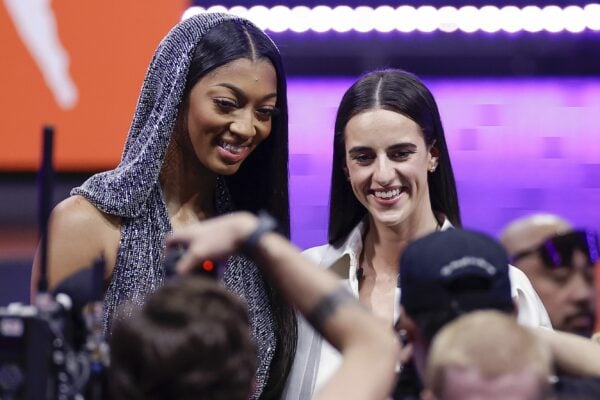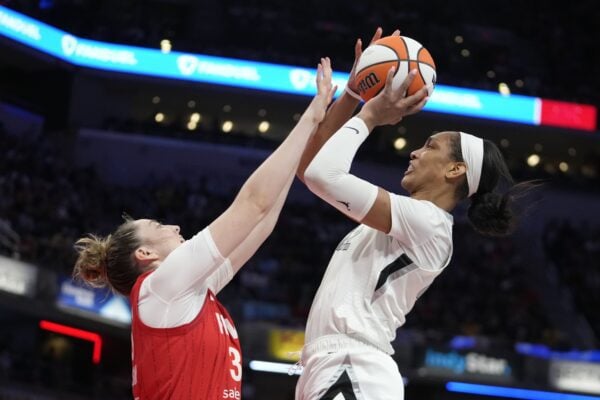The WNBA has a real-life salary problem.
Picture this: the energy is undeniable — sold-out arenas, record merchandise sales, unprecedented television viewership. Players like Paige Bueckers, Caitlin Clark and Angel Reese aren’t just playing basketball; they’re igniting a cultural phenomenon, drawing crowds and attention the WNBA has long dreamed of.
Yet, beneath the bright lights and burgeoning fandom lies an uncomfortable, persistent truth: the glaring salary gap separating these elite athletes from their NBA counterparts and even from a basic standard of fair market value.
While stars leverage endorsements — which often eclipse their league salaries many times over — the fundamental structure of WNBA compensation remains starkly inadequate for the majority. Rookies enter the league, making between $70,000 and $80,000 annually. The maximum base salary for a veteran in 2024 is $241,984.

Compare this to the NBA, where rookies start well into seven figures, the league minimum surpasses $1.1 million and superstars command $40 million to $50 million per season. The chasm isn’t just wide; it’s foundational.
“The talent, the dedication, the hours poured into this game are identical, if not greater for women navigating systemic hurdles,” said Jannon Lampley, a former WNBA player and current high school coach, echoing a sentiment growing louder within the league. “These girls train just as hard and sacrifice just as much. Seeing the crowds now, the excitement … Players are tired of being disrespected.”
Lampley experienced the league’s financial realities firsthand during her time with the Orlando Miracle in 2000. She hints at the rising frustration that could boil over: the potential for a lockout, or a season without WNBA basketball, is plausible.
Context and growth: A tale of two leagues

Understanding the disparity requires context, but context shouldn’t excuse stagnation. Analysis by BetArizona.com, utilizing data from Spotrac and inflation calculators, provides perspective. Adjusting for inflation, the average WNBA salary in its inaugural 1997 season was approximately $64,611. By 2025, estimates suggest this has risen to around $137,218 — a 112.4% increase.
Progress? Yes. Sufficient? Absolutely not.
Contrast this trajectory with the NBA. In 1947, the NBA — then known as the Basketball Association of America (BAA) — had anaverage inflation-adjusted salary of roughly $64,388. Fast forward to 2025 and the average NBA salary soars to nearly $12 million — an astronomical increase of over 18,400%.
A fairer comparison looks at league age. The NBA’s 25th year and their 1970-71 season featured 17 teams and an average salary of $90,000 (equivalent to roughly $700,000 today).
In its 28th season with 13 teams (with at least two more future franchises confirmed), the WNBA’s estimated average salary is significantly below that adjusted NBA figure from over 50 years prior.
The revenue conundrum and the CBA crucible

The league’s core argument has historically centered on revenue.
While growing rapidly, the WNBA still generates only a fraction of the NBA’s billions. Despite this, critics counter that investment drives growth, and player compensation is a crucial part of that investment. Under the current CBA, players receive approximately 50% of league revenue from media deals, which was negotiated in 2020. The NBA players receive a similar slice but out of a vastly larger cake.
This makes the WNBA’s upcoming media rights negotiations, set to begin sometime this year, absolutely paramount.
The current deal, worth around $60 million annually, is widely undervalued given the recent explosion in viewership and interest fueled by stars like Bueckers, Clark, Kiki Iriafen, Breanna Stewart, A’ja Wilson and (in a year or two) Juju Watkins.
Securing a significantly larger media deal — potentially worth hundreds of millions annually — is crucial in bridging the revenue gap and stimulating higher salaries.
The subsequent CBA negotiations, likely heating up in 2026, will be the battleground.

Players, upbeat about the league’s momentum and public support, are expected to push aggressively for a larger share of the new revenue, higher minimum salaries, better benefits, improved travel conditions (like charter flights, which a handful of franchises secured in the 2024 season) and enhanced revenue-sharing mechanisms.
As voices like Lampley mention, the threat of a lockout is real if owners fail to acknowledge the players’ increased value and contribution to the league’s rising fortunes and popularity.
For context, the May 20 game against the Indiana Fever and Chicago Sky was the most-watched WNBA regular season game in the last 25 years, drawing in nearly 3 million viewers.
It is also worth noting the game featured Caitlin Clark and Angel Reese, two of the league’s hottest stars.
Why are these women still receiving the short end of the paycheck when considering such figures?
Beyond the stars: The reality of roster insecurity

While Clark’s reported $76,535 rookie salary sparks headlines, the financial precarity extends far deeper.
Many veterans earn well below the maximum salary. Roster spots are fiercely competitive, and job security is minimal. Players drafted in April can be waived by May, left without a salary and often significant relocation costs, after dedicating their lives to reaching the pinnacle of their sport.
For those without lucrative endorsement portfolios — the majority of the league — the WNBA salary alone, especially for those who aren’t the stars, often necessitates playing overseas during the off-season to make ends meet, increasing physical strain and injury risk.
“This isn’t just about the top names you see on TV,” Lampley said. “It’s about the player fighting for the 10th or 11th spot, the one grinding every day in practice, who could be cut tomorrow. They deserve a living wage and some security for dedicating their prime years to this league.”
Pathways to progress

The league must capitalize on its current momentum to secure a transformative media rights package that is exponentially larger than the current deal.
Players must secure a significant portion of the new revenue generated, ensuring salaries rise proportionally to the league’s growth. Significantly raising the salary floor is crucial for rank-and-file players.
The league and team owners must double down on marketing its stars and the product, driving ticket sales, merchandise and sponsorships to boost overall revenue further. Players and the WNBA Players’ Association (WNBPA) should leverage their growing influence to negotiate sponsorship deals that benefit players or include bonuses tied to league revenue milestones.
One example is Las Vegas Aces (and former Seattle Storm) guard Jewell Loyd, whose endorsements offered her a significant monetary bonus if she averaged at least 20 points in the 2024 season.
Minnesota Lynx forward and co-founder of the Unrivaled Basketball League, Napheesa Collier, won the league’s championship and received a cash prize.
The prize? $200,000, the largest prize of its kind for any women’s tournament ever.
“Wow, I just made more than my WNBA salary,” Collier said during the prize presentation.
Collier, undoubtedly a top-10 player in the WNBA, only makes about $150,000 a season under her current contract.

It was also as if the reality was setting in for everyone in attendance: These women are worth so much more, and leagues like Unrivaled proved that easily. A league less than a year ago was able to muster up the largest cash prize for a women’s tournament, beating out the $150,000 mark for NCAA women’s tournament wins.
The WNBA is experiencing a renaissance. The talent is elite, the fanbase is expanding and the cultural relevance is indisputable.
Yet, the compensation structure remains anchored in an era of lower expectations. As record crowds check on record performances, the question isn’t just about fairness, sustainability and respect.
WNBPA president Nneka Ogwumike agrees.
“We are not just asking for a CBA that reflects our value,” Ogwumike said.
The upcoming media deal and CBA negotiations are more than contract talks; they are a referendum on whether the league truly values the athletes driving its unprecedented success.
Failure to address the glaring pay gap risks player unrest and stunts the WNBA’s finally achieving growth. The players, from rookies to veterans, have delivered. Now, it’s the league’s turn.
“We are demanding it because we’ve earned it,” Ogwumike said.
Contact Multi-Media & Senior Sports Reporter Noral Parham at 317-762-7846. Follow him on TikTok @3noral. For more WNBA coverage, click here. For more WNBA coverage, click here.
Noral Parham is the multi-media & senior sports reporter for the Indianapolis Recorder, one of the oldest Black publications in the country. Prior to joining the Recorder, Parham served as the community advocate of the MLK Center in Indianapolis and senior copywriter for an e-commerce and marketing firm in Denver.





